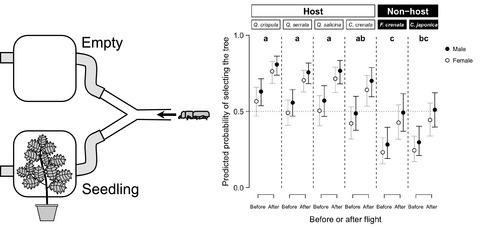当前位置:
X-MOL 学术
›
Entomol. Exp. Appl.
›
论文详情
Our official English website, www.x-mol.net, welcomes your
feedback! (Note: you will need to create a separate account there.)
Platypus quercivorus ambrosia beetles use leaf volatiles in host selection
Entomologia Experimentalis et Applicata ( IF 1.4 ) Pub Date : 2020-11-20 , DOI: 10.1111/eea.12993 Duy Long Pham 1 , Yasuto Ito 2 , Ryuichi Okada 3 , Hidetoshi Ikeno 4 , Haruna Kazama 5 , Naoki Mori 5 , Michimasa Yamasaki 1
Entomologia Experimentalis et Applicata ( IF 1.4 ) Pub Date : 2020-11-20 , DOI: 10.1111/eea.12993 Duy Long Pham 1 , Yasuto Ito 2 , Ryuichi Okada 3 , Hidetoshi Ikeno 4 , Haruna Kazama 5 , Naoki Mori 5 , Michimasa Yamasaki 1
Affiliation

|
Although chemical volatiles emitted from host and non‐host trees have been suggested as important cues for bark and ambrosia beetles, their responses to leaf volatiles is poorly understood. The oak ambrosia beetle, Platypus quercivorus (Murayama) (Coleoptera: Curculionidae), is a vector for the fungus that causes Japanese oak wilt. Using a Y‐tube olfactometer, we tested the behavioral response of P. quercivorus to leaf volatiles emitted from four host trees – Quercus crispula Blume, Quercus serrata Murray, Quercus salicina Blume, and Castanea crenata Sieb. & Zucc. (all Fagaceae) – and two non‐host trees, Fagus crenata Blume (Fagaceae) and Cryptomeria japonica D. Don (Cupressaceae). A flight mill was used to evaluate the effect of flight on the behavioral response to leaf volatiles. The bioassays were repeated 10× before and 10× after flight in the flight mill for each of the 54 individual beetles. Leaf volatile components were analyzed using gas chromatography–mass spectrometry. The bioassay results supported our hypothesis: P. quercivorus was attracted by the leaf volatiles of hosts and was deterred by the leaf volatiles of non‐hosts. The behavioral response of P. quercivorus to the leaf volatiles was stronger after flight. Males had a stronger behavioral response than females to leaf volatiles. The leaf volatile chemical profile of the non‐host C. japonica differed from the profile of the host plants. However, the chemical profile of the non‐host F. crenata was similar to the profile of the hosts. Our findings provide insight into the functions of leaf chemical volatiles in the interaction of P. quercivorus with its hosts and non‐hosts and may help improve the control of P. quercivorus and Japanese oak wilt.
中文翻译:

Platypus quercivorus ambrosia 甲虫在宿主选择中使用叶挥发物
尽管寄主和非寄主树木释放的化学挥发物已被认为是树皮和金银花甲虫的重要线索,但它们对叶挥发物的反应知之甚少。橡木龙涎香甲虫鸭嘴兽(Murayama)(鞘翅目: Curculionidae)是导致日本橡木枯萎病的真菌的载体。我们使用 Y 型管嗅觉计测试了 P. quercivorus 对从四种寄主树释放的叶子挥发物的行为反应 - Quercuscrispula Blume、Quercus serrata Murray、Quercus salicina Blume 和 Castanea crenata Sieb。&祖克。(所有山毛榉科) - 和两种非寄主树木,山毛榉(山毛榉科)和 Cryptomeria japonica D. Don(柏科)。飞行磨机用于评估飞行对叶片挥发物行为反应的影响。对于 54 只个体甲虫中的每只,在飞行磨机中飞行前和飞行后 10 次重复生物测定。使用气相色谱-质谱法分析叶片挥发性成分。生物测定结果支持我们的假设:P. quercivorus 被寄主的叶子挥发物吸引,并被非寄主的叶子挥发物吓倒。P. quercivorus 对叶挥发物的行为反应在飞行后更强。雄性对叶子挥发物的行为反应比雌性强。非寄主 C. japonica 的叶片挥发性化学特征与寄主植物的特征不同。然而,非寄主 F. crenata 的化学特征与寄主的特征相似。我们的研究结果提供了对叶片化学挥发物在 P. 相互作用中的作用的深入了解。
更新日期:2020-11-20
中文翻译:

Platypus quercivorus ambrosia 甲虫在宿主选择中使用叶挥发物
尽管寄主和非寄主树木释放的化学挥发物已被认为是树皮和金银花甲虫的重要线索,但它们对叶挥发物的反应知之甚少。橡木龙涎香甲虫鸭嘴兽(Murayama)(鞘翅目: Curculionidae)是导致日本橡木枯萎病的真菌的载体。我们使用 Y 型管嗅觉计测试了 P. quercivorus 对从四种寄主树释放的叶子挥发物的行为反应 - Quercuscrispula Blume、Quercus serrata Murray、Quercus salicina Blume 和 Castanea crenata Sieb。&祖克。(所有山毛榉科) - 和两种非寄主树木,山毛榉(山毛榉科)和 Cryptomeria japonica D. Don(柏科)。飞行磨机用于评估飞行对叶片挥发物行为反应的影响。对于 54 只个体甲虫中的每只,在飞行磨机中飞行前和飞行后 10 次重复生物测定。使用气相色谱-质谱法分析叶片挥发性成分。生物测定结果支持我们的假设:P. quercivorus 被寄主的叶子挥发物吸引,并被非寄主的叶子挥发物吓倒。P. quercivorus 对叶挥发物的行为反应在飞行后更强。雄性对叶子挥发物的行为反应比雌性强。非寄主 C. japonica 的叶片挥发性化学特征与寄主植物的特征不同。然而,非寄主 F. crenata 的化学特征与寄主的特征相似。我们的研究结果提供了对叶片化学挥发物在 P. 相互作用中的作用的深入了解。











































 京公网安备 11010802027423号
京公网安备 11010802027423号